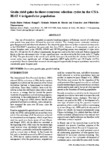Please use this identifier to cite or link to this item:
http://www.alice.cnptia.embrapa.br/alice/handle/doc/212564| Title: | Grain yield gains in three recurrent selection cycles in the CNA-IRAT 4 irrigated rice population. |
| Authors: | RANGEL, P. H. N.  MORAIS, O. P. de   ZIMMERMANN, F. J. P.   |
| Affiliation: | PAULO HIDEO NAKANO RANGEL, CNPAF ORLANDO PEIXOTO DE MORAIS, CNPAF FRANCISCO JOSE P ZIMMERMANN, CNPAF. |
| Date Issued: | 2002 |
| Citation: | Crop Breeding and Applied Biotechnology, v. 2, n. 3, p. 369-373, Sept. 2002. |
| Description: | One line of research on irrigated rice genetic breeding programs at Embrapa consists of synthesizing wide genetic base populations followed by recurrent selection. This strategy ensures systematic continuous gains for grain yield and other traits of interest. To estimate the gains observed in three recurrent selection cycles in the CNA-IRAT 4 population, the grain yield data from 924 S0:2 families in 14 experiments carried out in various Brazilian states in the 1992/93, 1994/95 and 1997/98 growing seasons were analyzed. A triple lattice (two 10 x 10 and two 8 x 8 lattices) expérimental design was used in the first cycle and Federer augmented blocks in the two subsequent cycles. A non -significant gain was observed in the first cycle (only 15.7 kg/ha (0.28%). The gain observed in the second cycle and the mean gain observed due the selection in the first and second cycles were significante and of high magnitude (369.9 kg/ha (6.65%) and 259.9 kg/ha (4.67%), respectively). Results showed that recurrent selection applied to genetically divergent populations can result in considerable gains for grain yield. |
| Thesagro: | Arroz Oryza Sativa Seleção Recorrente |
| NAL Thesaurus: | rice |
| Keywords: | Genetic gain Genetic breeding Irrigado |
| Type of Material: | Artigo de periódico |
| Access: | openAccess |
| Appears in Collections: | Artigo em periódico indexado (CNPAF)  |
Files in This Item:
| File | Description | Size | Format | |
|---|---|---|---|---|
| c8128f4252420eb9.pdf | 183,33 kB | Adobe PDF |  View/Open |









